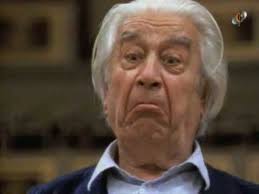
No, this post isn’t about following your intuition…today we’re talking about musical inner voices, those sometimes inconspicuous lines between the melody and the bass, which are often the essence of a piece’s drama. If you have any doubts about the importance of these lines, often played by violas and second violins in orchestral and string quartet repertoire, watch this short but funny clip of conductor Sergiu Celibidache rehearsing the Adagio from Anton Bruckner’s Symphony No. 7.
Ensemble playing is about teamwork and every part is essential to the whole. Let’s listen to a few orchestra excerpts, which are great examples of the power of inner voices.
Nimrod
Take a moment and think about all of your Facebook friends or cell phone contacts. Could you imagine music which would fit each personality? English composer Sir Edward Elgar (1857-1934) wrote a series of variations on this original theme, each depicting one of his friends. He assigned each variation a cryptic title, leaving audiences to guess who was being represented. The piece has commonly come to be known as the Enigma Variations. The variations run the gamut from lighthearted to fiery. One of the most famous and memorable parts of the piece is Variation IX, a moving chorale dedicated to Elgar’s publisher and close friend, August Jaeger. Listen carefully to the inner voices. Pay attention to the contour of the lines and the way they fit together. Listen for moments of harmonic tension:
https://www.youtube.com/watch?v=aqvOVGCt5lw
Tchaikovsky’s “Pathétique”
Tchaikovsky’s final work, Symphony No. 6 “Pathétique”, features a triumphantly rousing third movement, followed by a Finale which sinks into the deepest despair (Adagio lamentoso – Andante). What’s interesting is the way Tchaikovsky chooses to write the opening theme of the final movement. As a listener, you might make the logical assumption that the first violins play the prominent descending scale line (F-sharp, E, D, C-sharp, B, C-sharp). But the actual opening line for the first violins is B, E, G-sharp, C-sharp, E-sharp, C-sharp. It sounds pretty strange when played by itself. The second violin part has similar jumps. So who has the famous melody? It turns out that the melody and inner voices alternate back and forth between the first and second violins. Today the second violins in an orchestra typically sit next to the firsts, but in Tchaikovsky’s day, the seconds faced the firsts on the other side of the stage (where the cellos usually are now). Tchaikovsky achieved the nineteenth century equivalent of surround sound.
In this performance, conducted by Valery Gergiev, the second violins are seated across from the firsts:
https://www.youtube.com/watch?v=W_KS-wMiDpg
Beethoven’s Fifth Symphony
In the final movement of Beethoven’s Symphony No. 5, a seemingly insignificant inner voice becomes the star of the show. Listen to the supporting voice at 1:11, which mirrors the top voice in contrary motion. As the development section begins, we hear it again (4:28), then more prominently in the trombones. Listen as this inner voice is transformed into a powerful, heroic proclamation played by the whole orchestra (5:28).
What are your favorite inner voices? Share your own listening suggestions in the thread below.
